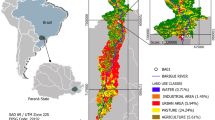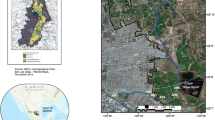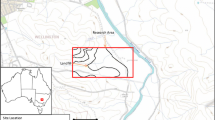Abstract
For about 10 years, environmental tracing development using dissolved organic matter (DOM) has been the subject of several studies. Particularly, the use of characterization techniques, like fluorescence emission–excitation matrices has enabled the identification of DOM sources and monitoring them within mainland or marine hydrosystems. Moreover, hydrogeologists have shown the significance of total organic carbon content used as a fast seepage tracer in karstic aquifers. The aim of this study consists in using DOM fluorescence signals to develop a transit time semi-quantitative tracer in heterogeneous hydrosystems. The Low-Noise Underground Laboratory (Vaucluse, France) cuts the network of Fontaine de Vaucluse (FV) karstic vadose zone randomly, and offers a special access to different unstructured dripwaters, with different hydrodynamic behaviour, inside its galleries, i.e. not hierarchical as in natural caves. Previous long-term hydrodynamic and hydrochemical studies allowed the understanding of their hydrogeological behaviour and the estimation of mean transit times. That is why this site is adequate to develop new transit time tracers. After identification of the different DOM sources (i.e. lithic and rendzic leptosols), fluorescence intensities monitoring from soil leachates and dripwaters, for certain excitation–emission wavelength pairs, allowed the development of punctual transit time tracing, by spotting infiltration periods of fluorescent compounds, and monitoring their transfer within a hydrosystem. A fluorescence index (humification index) and the mean transit time of each gallery groundwater, stemmed from previous hydrodynamic and hydrochemical studies, allowed the calibration of a logarithmic relationship. This one allows the development of a continuous transit time tracing method that estimates transit times without long-term studies. It has been tested on two springs of FV catchment basin, providing transit time estimations for karstic hydrosystems that do not present a mixture between recent and pluriannual waters.







Similar content being viewed by others
References
Baker A, Genty D (1999) Fluorescence wavelength and intensity variations of cave waters. J Hydrol 217(1–2):19–34
Baker A, Lamont-BIack J (2001) Fluorescence of dissolved organic matter as a natural tracer of ground water. Ground Water 39(5):745–750
Batiot C (2002) Etude expérimentale du cycle du carbone en régions karstiques. Apport du carbone organique et du carbone minéral à la connaissance hydrogéologique des systèmes. Site expérimental de Vaucluse, Jura, Larzac, Région Nord-Montpelliéraine, Nerja (Espagne). PhD Thesis, Université d’Avignon et des Pays de Vaucluse, Avignon, France
Batiot C, Emblanch C, Blavoux B (2003) Total organic carbon (TOC) and magnesium (Mg2+): two complementary tracers of residence time in karstic systems. Comptes Rendus Geosci 335(2):205–214
Birdwell JE, Engel AS (2010) Variability in terrestrial and microbial contributions to dissolved organic matter fluorescence in the Edwards aquifer, central Texas. J Cave Karst Stud 71(2):144–156
Blavoux B, Mudry J, Puig J-M (1992) Rôle du contexte géologique et climatique dans la genèse et le fonctionnement du karst de Vaucluse, vol 13. IAH Intern, Hannover
Blondel T (2008) Traçage spatial et temporel des eaux souterraines dans les hydrosystèmes karstiques par les MOD. Expérimentation et application sur les sites du LSBB et de Fontaine de Vaucluse. PhD Thesis, Université d’Avignon et des Pays de Vaucluse, Avignon, France
Blondel T, Travi Y, Emblanch C, Dudal Y (2010) Organic matter as a potential complementary tool for δ18O data interprétation in heterogeneous aquifers. Isotopes Environ Health Stud 46(1):27–36
Chen W, Westerhoff PK, Leenheer JA, Booksh K (2003) Fluorescence excitation–emission matrix regional integration to quantify spectra for dissolved organic matter. Environ Sci Technol 37(24):5701–5710
Christ M, David MB (1994) Fractionation of dissolved organic carbon in soil water: effects of extraction and storage methods. Commun Soil Sci Plant Anal 25(19/20):3305–3319
Coble P (1996) Characterization of marine and terrestrial DOM in seawater using excitation–emission matrix spectroscopy. Marine Chem 51:325–346
Cognard-Plancq A-L, Gevaudan C, Emblanch C (2006) Historical monthly rainfall-runoff database on Fontaine de Vaucluse karst system : review and lessons. In: Karst, cambio climatico y aguas submediterraneas, Malaga, pp 465–475
Emblanch C, Blavoux B, Puig J-M, Mudry J (1998a) Dissolved organic carbon of infiltration within the karst hydrosystem. Geophys Res Lett 25(9):1459–1462
Emblanch C, Puig JM, Blavoux B, Couren M (1998b) Premières investigations sur le rôle de la zone non saturée dans les aquifères karstiques à l’aide du 13C. Compte Rendu de l’Académie des Sciences de Paris (série II) 326(5):327–332
Filip Z, Tesařová M (2004) Microbial degradation and transformation of humic acids from permanent meadow and forest soils. Int Biodeterioration Biodegradation 54(2–3):225–231
Fleury P, Plagnes V, Bakalowicz M (2007) Modelling of the functioning of karst aquifers with a reservoir model: application to Fontaine de Vaucluse (South of France). J Hydrol 345(1–2):38–49
Garry B (2007) Etude des processus d’écoulement de la zone non saturée pour la modélisation des aquifères karstiques. Expérimentation hydrodynamique et hydrochimique sur les sites du Laboratoire Souterrain à Bas Bruit (LSBB) de Rustrel et de Fontaine de Vaucluse. PhD Thesis, Université d’Avignon et des Pays du Vaucluse, Avignon, France
Garry B, Blondel T, Emblanch C, Sudre C, Bilgot S, Cavaillou A, Boyer D, Auguste M (2008) Contribution of artificial galleries to knowledge of karstic system behaviour in addition to natural cavern data. Int J Speleol 37(1):75–82
Greenland DJ (1971) Interaction between humic and fulvic acids and clays. Soil Sci 111(1):34–41
Gu B, Schmitt J, Chen Z, Liang L, McCarthy JF (1994) Adsorption and desorption of natural organic matter on iron oxide. Mechanisms and models. Environ Sci Technol 28(1):38–46
Hall GJ, Clow KE, Kenny JE (2005) Estuarial fingerprinting through multidimensional fluorescence and multivariate analysis. Environ Sci Technol 39(19):7560–7567
Hudson N, Baker A, Reynolds D (2007) Fluorescence analysis of dissolved organic matter in natural, waste and polluted waters—a review. River Res Appl 23:631–649
Juhna T, Klavins M, Eglite L (2003) Sorption of humic substances on aquifer material at artificial recharge of groundwater. Chemosphere 51(9):861–868
Kaiser K, Guggenberger G (2003) Mineral surfaces and soil organic matter. Eur J Soil Sci 54(2):219–236
Kaiser K, Guggenberger G, Haumaier L, Zech W (2002) The composition of dissolved organic matter in forest soil solutions: changes induced by seasons and passage through the mineral soil. Org Geochem 33(3):307–318
Kelleher BP, Simpson AJ (2006) Humic substances in soils: are they really chemically distinct? Environ Sci Technol 40(15):4605–4611
Kögel-Knabner I (2000) Analytical approaches for characterizing soil organic matter. Org Geochem 31:609–625
Lapworth DJ, Gooddy DC, Butcher AS, Morris BL (2008) Tracing groundwater flow and sources of organic carbon in sandstone aquifers using fluorescence properties of dissolved organic matter (DOM). Appl Geochem 23(12):3384–3390
Larsen LG, Aiken GR, Harvey JW, Noe GB, Crimaldi JP (2010) Using fluorescence spectroscopy to trace seasonal DOM dynamics, disturbance effects, and hydrologic transport in the Florida Everglades. J Geophys Res Biogeosci 115 (in press)
Lastennet R, Puig J-M, Emblanch C, Blavoux B (1995) Influence de la zone non saturée sur le fonctionnement des systèmes karstiques. Mise en évidence dans les sources du Nord-Vaucluse. Hydrogéologie 4:57–66
Lombardi AT, Jardim WF (1999) Fluorescence spectroscopy of high performance liquid chromatography fractionated marine and terrestrial organic materials. Water Res 33(2):512–520
Mariot M, Dudal Y, Furian S, Sakamoto A, Vallès V, Fort L, Barbiero L (2007) Dissolved organic matter fluorescence as a water-flow tracer in the tropical wetland of Pantanal of Nhecolândia. Br Sci Total Environ 388(1–3):184–193
Masse JP (1968) L’Urgonien de Sault (Vaucluse). Bull Soc Geol France 9(4):495–596
Masse JP (1972) Structures cryptalguaires libres dans un complexe carbonaté de plate-forme: les calcaires urgoniens (Barrémien) de Provence (Sud-est de la France) In: 24th International Geological Congress, Montréal, pp 572–585
Maurice LD, Atkinson TC, Barkera JA, Bloomfieldb JP, Farrantb AR, Williams AT (2006) Karstic behaviour of groundwater in the English Chalk. J Hydrol 330(1–2):63–70
Mayer LM, Xing BS (2001) Organic matter-surface area relationships in acid soils. Soil Sci Soc Am J 65(1):250–258
McGuire KJ, McDonnell JJ (2006) A review and evaluation of catchment transit time modeling. J Hydrol 330(3–4):543–563
Ohno T (2002) Fluorescence inner-filtering correction for determining the humification index of dissolved organic matter. Environ Sci Technol 36:742–746
Parlanti E, Wörz K, Geoffroy L, Lamotte M (2000) Dissolved organic matter fluorescence spectroscopy as a tool to estimate biological activity in a coastal zone submitted to anthropogenic inputs. Org Geochem 31(12):1765–1781
Phillips FM, Castro MC (2005) Groundwater dating and residence-time measurements. In: Drever JI (ed) Surface and groundwater, weathering, and soils, Kidlington, UK, pp 451–498
Puig J-M (1987) Le système karstique de la Fontaine de Vaucluse. PhD Thesis, Université d’Avignon et des Pays de Vaucluse, Avignon, France
Puig J-M (1990) L’impluvium de la Fontaine de Vaucluse, morphologie, géologie, hydrologie. In: Gaubert et al. (ed) Les cavernes d’Albion. Hydrologie et spéléologie des territoires alimentant en eau la Fontaine de Vaucluse, vol 1. Association de Recherches et d’Etudes Hydrologiques du Plateau d’Albion edn, pp 15–32
Senesi N, Miano TM, Provenzano MR, Brunett G (1991) Characterization, differentiation and classification of humic substance by fluorescence spectroscopy. Soil Sci 152:259–271
Siano DB, Metzler DE (1969) Band shapes of the electronic spectra of complex molecules. J Chem Phys 51:1856–1961
Stedmon CA, Markager S, Bro R (2003) Tracing dissolved organic matter in aquatic environments using a new approach to fluorescence spectroscopy. Marine Chem 82:239–254
Velapoldi RA, Mielenz KD (1979) Standard reference material 936: quinine sulfate dihydrate. National Bureau of Standards, Washington, DC
Wu F, Tanoue E (2001) Molecular mass distribution and fluorescence characteristics of dissolved organic ligands for copper(II) in Lake Biwa. Jpn Org Geochem 32(1):11–20
Wu FC, Mills RB, Cai YR, Evans RD, Dillon PJ (2005) Photodegradation-induced changes in dissolved organic matter in acidic waters. Can J Fish Aquatic Sci 62(5):1019–1027
Zsolnay A, Baigar E, Jimenez M, Saccomandi B (1999) Differentiating with fluorescence spectroscopy the sources of dissolved organic matter in soils subjected to drying. Chemosphere 38:45–50
Acknowledgments
We thank S. Gaffet (CNRS Sophia-Antipolis) for access to the LSBB site. R. Simler, M. Daniel, M. Babic (UMR EMMAH) and D. Boyer, A. Cavaillou, M. Auguste (LSBB) and G. Daudin (INRA Montpellier) are acknowledged for their help in analysis.
Author information
Authors and Affiliations
Corresponding author
Rights and permissions
About this article
Cite this article
Blondel, T., Emblanch, C., Batiot-Guilhe, C. et al. Punctual and continuous estimation of transit time from dissolved organic matter fluorescence properties in karst aquifers, application to groundwaters of ‘Fontaine de Vaucluse’ experimental basin (SE France). Environ Earth Sci 65, 2299–2309 (2012). https://doi.org/10.1007/s12665-012-1562-x
Received:
Accepted:
Published:
Issue Date:
DOI: https://doi.org/10.1007/s12665-012-1562-x




